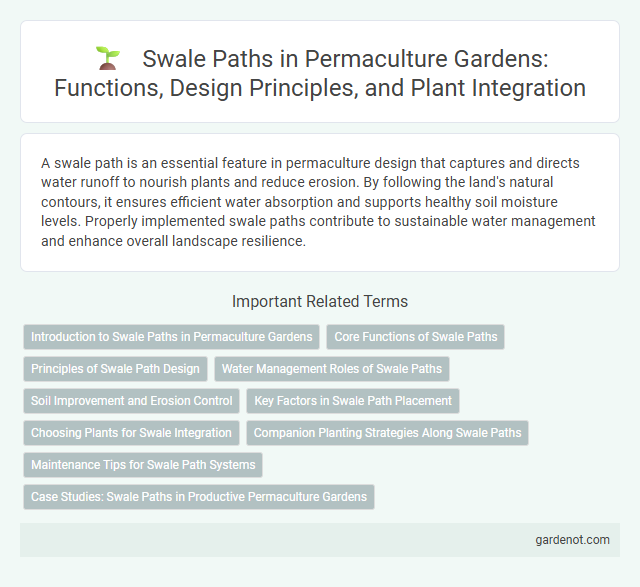A swale path is an essential feature in permaculture design that captures and directs water runoff to nourish plants and reduce erosion. By following the land's natural contours, it ensures efficient water absorption and supports healthy soil moisture levels. Properly implemented swale paths contribute to sustainable water management and enhance overall landscape resilience.
Introduction to Swale Paths in Permaculture Gardens
Swale paths are earth-contoured trenches in permaculture gardens designed to capture and channel rainwater, preventing soil erosion and promoting water infiltration. Situated along contour lines, these swales effectively distribute moisture to surrounding plants, enhancing soil fertility and reducing the need for irrigation. Integrating swale paths supports sustainable water management and creates microclimates that boost garden productivity.
Core Functions of Swale Paths
Swale paths primarily function to capture and slow down runoff water, promoting infiltration into the soil and reducing erosion on slopes. They enhance soil moisture retention, supporting plant growth and increasing resilience in permaculture landscapes. By directing water efficiently, swale paths contribute to ecosystem health and sustainable land management.
Principles of Swale Path Design
Swale path design in permaculture prioritizes contour alignment to maximize water catchment and minimize soil erosion. Incorporating gentle slopes and natural vegetation enhances water infiltration and supports biodiversity. Ensuring proper spacing and depth maintains effective water retention while preventing stagnation or overflow.
Water Management Roles of Swale Paths
Swale paths play a crucial role in permaculture water management by capturing and infiltrating rainwater, reducing soil erosion, and replenishing groundwater. These contour-based channels slow runoff, allowing water to percolate into the soil, which enhances moisture retention and supports plant health. Strategic placement of swale paths improves landscape hydration, promoting sustainable water cycles and increasing agricultural productivity.
Soil Improvement and Erosion Control
Swale paths are key permaculture features designed to enhance soil structure by capturing and directing water flow, which promotes deep moisture infiltration and nutrient retention. Their strategic placement on contour lines reduces surface runoff, effectively minimizing soil erosion and preserving topsoil integrity. By maintaining consistent hydration and preventing nutrient leaching, swales contribute to long-term soil fertility and ecosystem resilience.
Key Factors in Swale Path Placement
Swale path placement depends primarily on contour lines to effectively capture and distribute water across the landscape. Soil type and permeability influence the swale's ability to retain moisture and prevent erosion, while slope gradient ensures proper water flow without causing runoff. Vegetation proximity and existing land use patterns also play a crucial role in maximizing the ecological benefits and integration of swales within the permaculture design.
Choosing Plants for Swale Integration
Selecting drought-tolerant, deep-rooted plants such as native grasses, nitrogen-fixing legumes, and hardy shrubs ensures optimal water infiltration and soil stabilization in swale paths. Incorporating diverse species like comfrey, yarrow, and mulberry enhances nutrient cycling and supports beneficial insect habitats within the swale ecosystem. Prioritize plants with high transpiration rates and expansive root systems to maximize swale effectiveness in erosion control and moisture retention.
Companion Planting Strategies Along Swale Paths
Swale paths enhance water retention and soil fertility, creating ideal conditions for companion planting strategies that boost plant health and yield. Utilizing nitrogen-fixing plants like legumes alongside deep-rooted species such as comfrey improves nutrient cycling and supports a diverse ecosystem. Integrating flowering plants attracts beneficial pollinators and natural pest predators, promoting sustainable permaculture garden productivity.
Maintenance Tips for Swale Path Systems
Regular inspection and clearing of swale paths prevent sediment buildup and ensure efficient water flow. Incorporating mulch and planting deep-rooted vegetation along swale edges reduces erosion and promotes soil stability. Periodic reshaping after heavy rains maintains the contour integrity essential for optimal water absorption in permaculture landscapes.
Case Studies: Swale Paths in Productive Permaculture Gardens
Swale paths in productive permaculture gardens significantly enhance water retention and soil fertility by directing runoff into contour trenches, preventing erosion and promoting plant growth. Case studies reveal increased crop yields in swale-integrated gardens compared to conventional setups, with species like fruit trees and nitrogen-fixing plants thriving along the swales. These examples demonstrate how strategic swale design fosters resilient, sustainable ecosystems that optimize rainfall infiltration and resource efficiency.
Swale path Infographic

 gardenot.com
gardenot.com